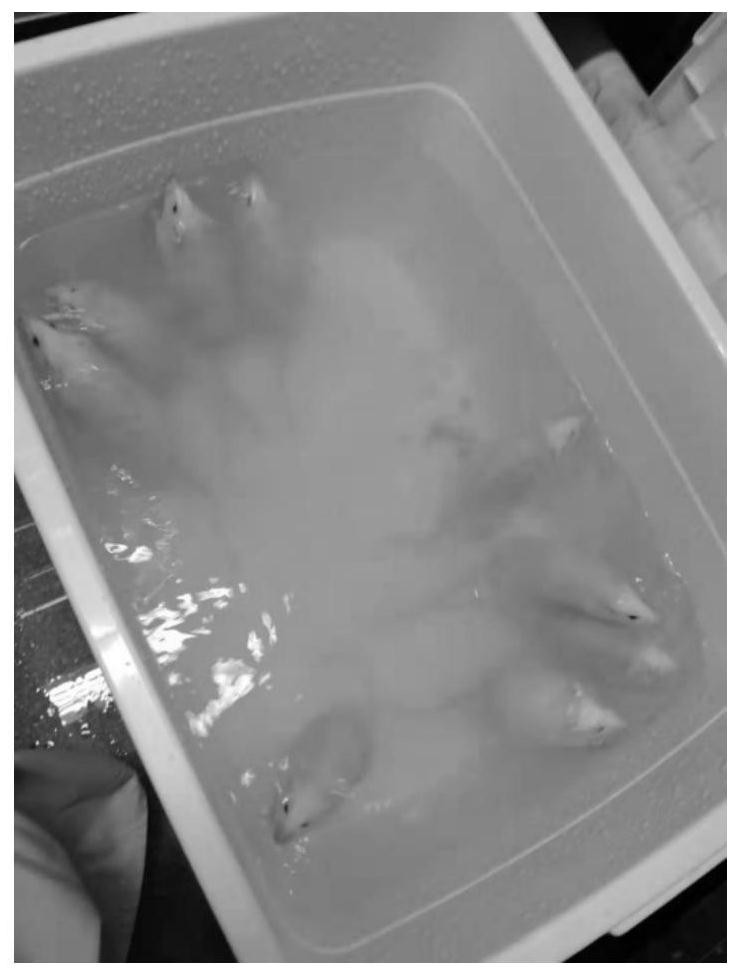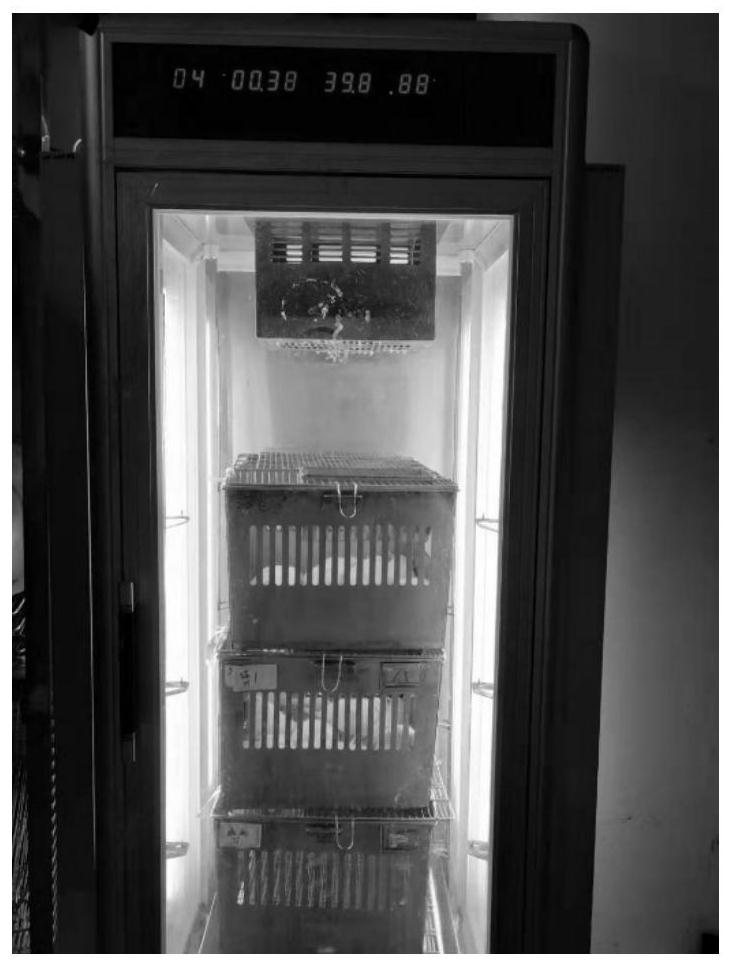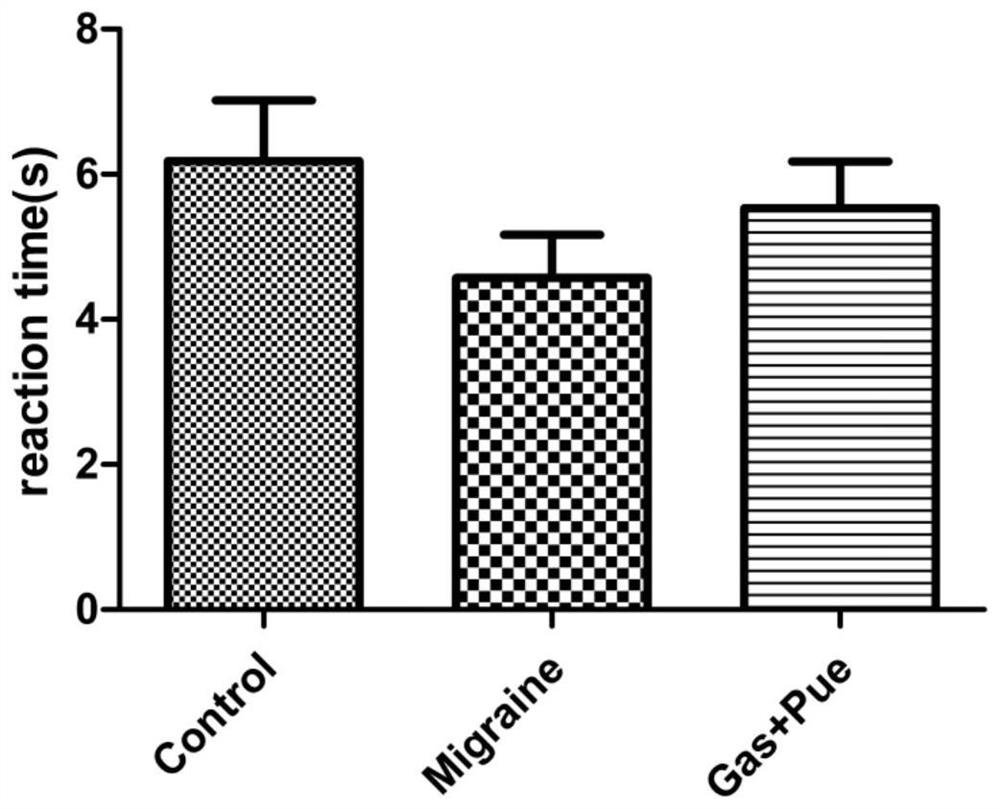A modeling method for migraine model rats with wind-heat syndrome
A technology for migraine and wind-heat syndrome, which is applied to the modeling field of wind-heat migraine model rats. good effect
- Summary
- Abstract
- Description
- Claims
- Application Information
AI Technical Summary
Problems solved by technology
Method used
Image
Examples
Embodiment 1
[0038] Acquisition and identification of migraine model of wind-heat syndrome
[0039] 1. Experimental consumables
[0040] 1.1 Experimental animals: 60 SPF grade male SD rats, each weighing 180-220g, were purchased from Beijing Weitong Lihua Experimental Animal Research Center, license number: SCXK (Beijing) 2016-0006, and the animals were kept in clean grade Animal room, indoor temperature 22±2°C, relative humidity 30-40%, 5 rats per cage, drinking tap water sterilized by high-pressure steam, and feeding ordinary rat pellets by themselves. The experiments were carried out after the animals were adaptively fed for 3 days after purchase.
[0041] 1.2 Experimental drugs: gastrodin tablets, produced by Shanghai Modern Hasen (Shangqiu) Pharmaceutical Co., Ltd., daidzein tablets (puerarin tablets), produced by Shanxi Aoer Pharmaceutical Co., Ltd. The daily dose of Gastrodin Tablets for adults is 150-300 mg. In this experiment, 300 mg is used. The dose for rats is calculated as...
Embodiment 2
[0052] The steps of detection of CGRP protein immunopositive reactants in brain slices of each group are as follows:
[0053] 1. Immunohistochemical staining:
[0054] (1) Transfer the brain tissue slices to a 24-well plate, suck off the antifreeze, and rinse with 0.01MPBS for 3×5min;
[0055] (2) Add prepared 1% Triton-100, 500 μl per well, incubate at 37°C for 1 hour on a constant temperature shaker;
[0056] (3) Aspirate 1% Triton-100, add 0.01MPBS, rinse 3×5min;
[0057] (4) Add the prepared 3% H 2 o 2 , 500 μl per well, place at room temperature in the dark for 15 minutes;
[0058] (5) Rinse with pure water for 2×5min, and rinse with 0.01MPBS for 10min;
[0059] (6) Add 10% goat serum blocking solution, 500 μl per well, incubate at 37°C for 1 hour on a constant temperature shaker;
[0060] (7) Aspirate the blocked goat serum without rinsing, and directly add the CGRP primary antibody diluted in antibody diluent (dilution ratio 1:1000), 500 μl per well, first incubat...
Embodiment 3
[0070] Detection of RAMP1 and CRLR protein expression in the thalamus, trigeminal ganglion, and spinal nucleus of the trigeminal nerve, the steps are as follows:
[0071] 1. Weston-blot process:
[0072] 1.1 Protein extraction:
[0073] (1) Mark and weigh the centrifuge tube, and place it on the centrifuge tube rack. Take the tissue out of the -70°C refrigerator, quickly pick the tissue in the original tube into the prepared specimen centrifuge tube with clean tweezers on the ice tray, weigh it again, and calculate the difference;
[0074] (2) Add the lysate with a difference of 10 times (μl) into the centrifuge tubes of each specimen, and homogenize with a hand-held electric homogenizer. The liquid in the centrifuge tube is transferred to the sample centrifuge tube;
[0075] (3) Put the sample centrifuge tube in a centrifuge, centrifuge at 4°C, 12000 rpm, and centrifuge for 15 minutes;
[0076] (4) Carefully draw the supernatant into another centrifuge tube and store at -...
PUM
 Login to View More
Login to View More Abstract
Description
Claims
Application Information
 Login to View More
Login to View More - Generate Ideas
- Intellectual Property
- Life Sciences
- Materials
- Tech Scout
- Unparalleled Data Quality
- Higher Quality Content
- 60% Fewer Hallucinations
Browse by: Latest US Patents, China's latest patents, Technical Efficacy Thesaurus, Application Domain, Technology Topic, Popular Technical Reports.
© 2025 PatSnap. All rights reserved.Legal|Privacy policy|Modern Slavery Act Transparency Statement|Sitemap|About US| Contact US: help@patsnap.com



